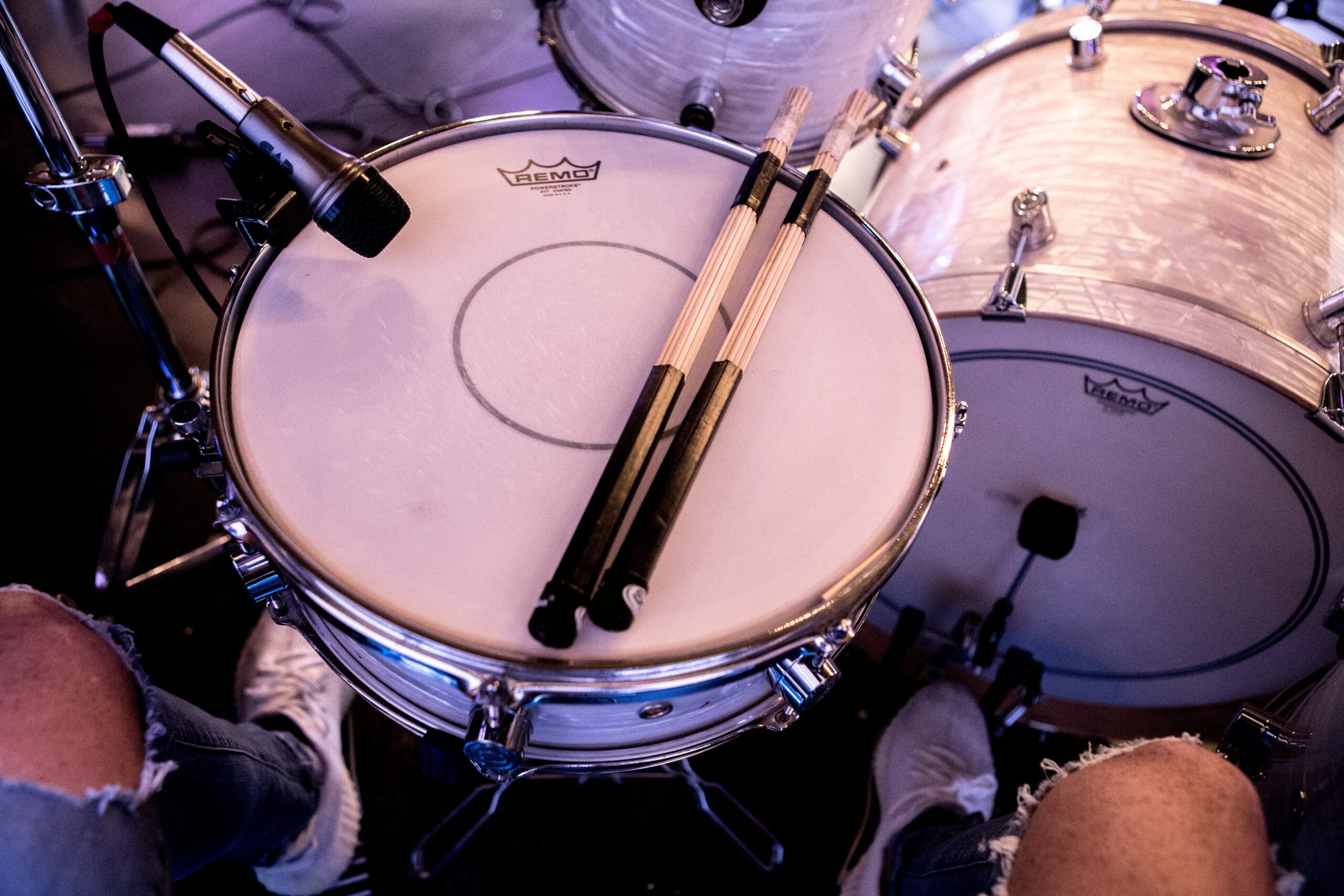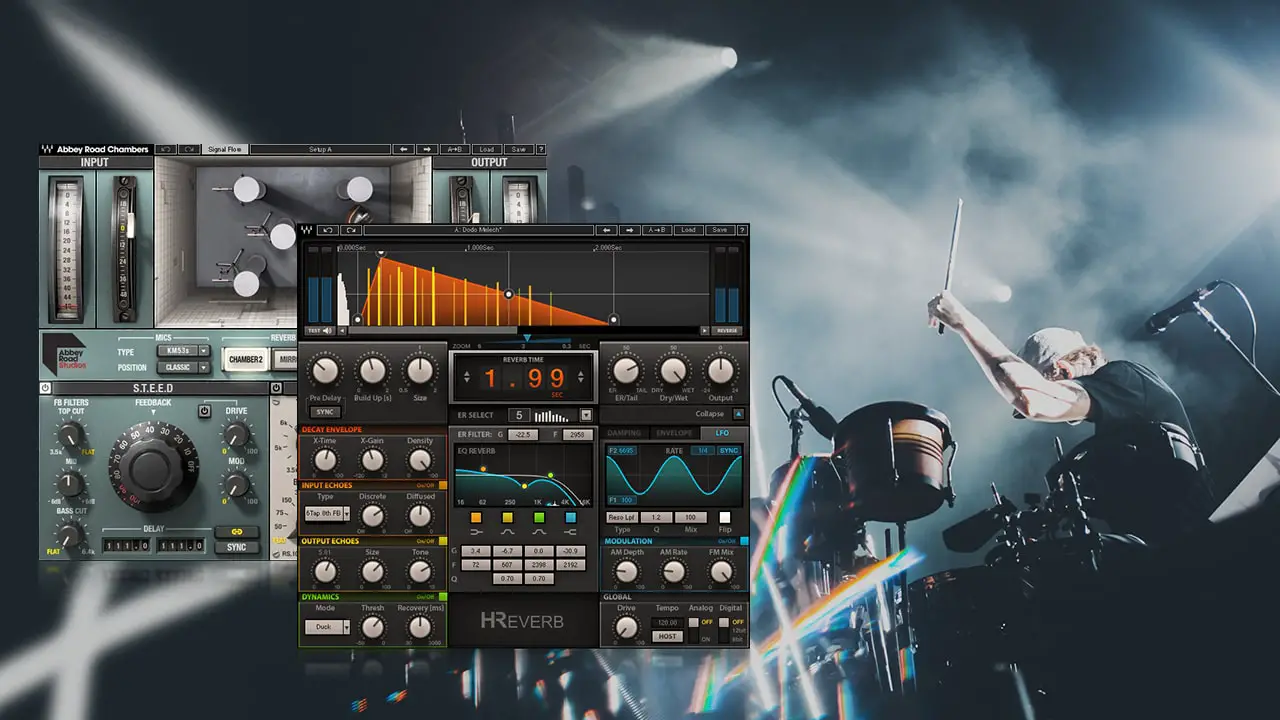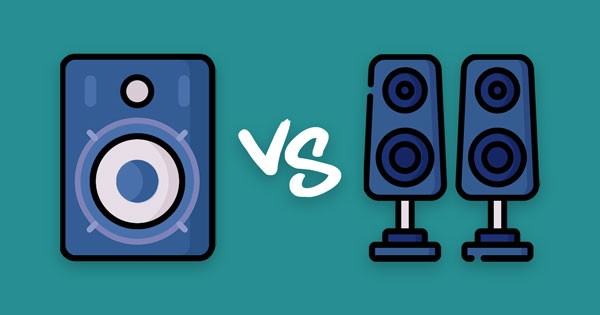I just received an email from one of my blog readers asking me should drums be mono or stereo.
Having your drums in mono is often ideal when you’re recording a live drum kit to help prevent phasing issues that usually occur when recording in stereo.
When dealing with samples or VST instruments this is typically less of an issue. However, you still need to be aware of phasing when you start panning drum tracks.
The Difference Between Mono and Stereo
It’s crucial to understand the difference between mono and stereo before pushing the record button.
Mono is simple to understand because the word is self-explanatory. Mono means one, so one recording with one microphone onto one channel. Mono tracks will output the same audio from both speakers (L+R).
Stereo is often 2 channels, the left and right. Stereo sends two audio signals, one for each speaker.
It allows you the possibility to record something unique on the left channel and something different on the right.
With stereo, each ear receives a signal that is different from that of the other ear. With mono, both your ears get the same/identical signal.
Mono vs Stereo (Pros & Cons)
Stereo gives you a sense of realism, space, and 3 dimensions to be able to hear the audio as if you were in the room. It also allows you to locate the direction of each sound.
However, with stereo recordings, you might have some phase issues when using multiple microphones.
It also requires a lot of equipment, you need both of each piece of gear. 2 of the same microphone, 2 of the same mic preamps, EQs, compressors, etc.
Then there’s mono. With mono you won’t have phase issues. It’s much easier to set up and doesn’t require a big budget.
You can double-track to get your mono signals similar to stereo.
Which Drums Should Be Mono or Stereo
Now that we understand the difference we can start going into which drum sounds should be stereo or mono.
We’ll start with the kick drum.
Kick Drum is Normally Mono

When you pan sounds or use stereo image tools to make instruments sound wider you’re basically pushing them at the back of the mix.
Low-end sounds such as the kick need to be mono so that they can be upfront and sound huge in a mix.
So, drum instruments that are heavy in bass (kicks and 808s) tend to sound best when they are centered in the stereo image.
Since low frequencies aren’t directional, humans can't distinguish the direction of very low frequencies easily, or at all. That's why most sound systems come with one subwoofer, and it’s never stereo.
This is why it’s often a great idea to keep the kick drum in the center.
There’s nothing wrong with a stereo kick drum, just make sure that you keep switching between mono and stereo.
Getting the kick mono-compatible will make your mix sound great everywhere no matter the environment or sound system.
Snare Can Be Stereo/Mono

When it comes to the snare, it’s just a matter of preference and the direction or goal of the song.
If the snare is part of the groove and needs to be upfront (like in a rap song, for instance) then placing it in the center is normally the best decision.
This way the snare will have more impact and sound more punchy.
When the snare is not driving the song, then having it in stereo is not a bad idea. In this case, it’s totally up to you whether you want it to be mono or stereo.
However, if you choose to record in stereo always check that the snare is mono-compatible and doesn’t disappear when the mix is played in mono or causes any phase issues.
You can also have the best of both worlds. For instance, you can use a multiband stereo imager plugins to widen the top-end and high mids only.
This way, the high frequencies of the snare will be stereo while keeping all the impact and punch in the lower mid frequencies.
Hi-hats and Cymbals

As mentioned above, low-end heavy sounds tend to be centered to get them to sound powerful in a song.
The opposite applies when it comes to higher frequency drum sounds. High frequencies are mostly recorded in stereo.
So hi-hats, crashes, and rides don’t need to be punchy because their fundamental frequencies are in the high midrange and top-end.
This also applies to high percussion sounds such as the tambourine, shaker, chimes, cowbell, clave, etc.
That doesn’t necessarily mean you can’t record them in mono. These days, you can use plugins to place these drum sounds in a space to make them sound 3D.
Toms

When it comes to Tom drums, it really depends on the song. Are the toms part of the groove or do they play only in certain parts of the song, as part of the drum roll?
That’s what will regularly determine if the toms will be mono or stereo.
If they’re part of the groove then to make them sound more powerful you’ll need to keep them in the center.
Just make sure that they don’t clash with other sounds in the mix. You can use EQ to carve out space for them to fit perfectly.
If the toms are part of the groove but in the background then in that situation, it’s just a matter of taste.
When the toms only play in the drum roll to introduce certain parts of the song (maybe from verse to chorus) then they can be stereo and panned to taste.
This way they create drama and add excitement for the listener.
Low Percussion

For low percussion sounds such the conga, timbale, bongo, cajon, etc. it really depends on the type of music you’re working on.
A Latin song will usually have no kick drum so to have more impact you’ll need to record the low percussion sounds in mono.
If the song has both drums and percussion then in that situation, the percussion can be in stereo to add excitement and fill up the stereo image.
However, for low percussion, the first instinct would be to track them in mono. This way you'll have more flexibility when mixing to either keep them tight and in your face or make them spacious.
Overheads & Room Mics

Most often overheads and room mics are used to capture the spacious and 3-dimensional feel. They usually capture higher frequencies of the drum kit that’s why recording them in stereo makes more sense.
In some recordings, you may find both overheads and room mics in mono. Typically in this situation, these mono tracks are there to tighten up the snare and kick drum.
So, to get solid overheads it’s wiser to record them in both mono and stereo. This also applies to room microphones as well.
This approach will give you much more flexibility and control during the mixing stage.
Should Reverb Be Mono or Stereo?

Image Credits: waves.com
The same principles mentioned above apply to reverbs as well. Deciding whether the reverb should be mono or stereo will all be determined by what you want to achieve for a particular drum sound.
If you want to keep your drums upfront and punchy then a short mono reverb like a plate or room verb will be perfect for the job.
However, if you would like to push some sounds to the back of the mix and have a spacious effect then you can use a stereo reverb.
To keep things sounding more realistic you can pan the reverb signal exactly how you panned your individual drum sounds.
There’s no need to add multiple reverb Fx channels to do this, each software does this differently but you can use one reverb and pan it multiple ways on the individual drum channels. Read the manual 😛
So, utilize short mono reverbs to get a tighter and upfront reverb sound. For a wide and spacious effect then use a medium to long stereo reverb.
Wrap
One other thing you can do is layering, in terms of mono and stereo. So, you can layer a mono tom drum with a stereo tom.
This will give you a tight and wider sound at the same time. You can do the same for the snare, kick, and other low percussion sounds.
At the end of the day, it’s just a matter of preference and what works best for the particular song that you’re currently working on.
Always test till you find what works best for each song. Don’t rely too much on fixing things in the mixing stage.
Strive to get the right sound straight from the source.

